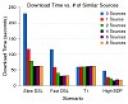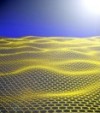 Today’s claims in the media about the recently discovered obesity gene are at best overwrought and at worst downright dangerous. A vast study involving more than twenty research centres across the UK has allegedly demonstrated that almost one fifth of us carry a variant of the gene known as FTO that predisposes us to obesity or overweight.
Today’s claims in the media about the recently discovered obesity gene are at best overwrought and at worst downright dangerous. A vast study involving more than twenty research centres across the UK has allegedly demonstrated that almost one fifth of us carry a variant of the gene known as FTO that predisposes us to obesity or overweight.
According to the researchers, “Obesity is a serious international health problem that increases the risk of several common diseases.” Fair comment. They add that, “The genetic factors predisposing to obesity are poorly understood.” Another fair comment.
They then report that while carrying out a genome-wide search for type 2 diabetes susceptibility genes among 13 groups of almost 40000 participants they have identified a common variant in the FTO gene that predisposes to diabetes through an effect on body mass index (BMI).
Additionally, the team reports that there is a cumulative, or additive, association of the variant with BMI. They found that 16% of the adults with the risky genetics weighed about 3 kilograms more than the others and were almost twice as likely to be obese, when compared to people without the risk allele. Moreover, the team says that they observe this genetic risk factor in individuals age 7 years and older and say that it reflects a specific increase in fat mass.
But, all this talk of obesity being down to genes will provide many individuals with an excuse along the lines of “it’s my glands”, which has become something of a serious cliche for some people who simply refuse to reduce the calorie intake and to add serious amounts of exercise to their daily routine.
The politics of obesity aside, I contacted metabolic expert Jeremy Nicholson of Imperial College London who recently discovered that calorie restriction in dogs extends life, reduces the risk of diabetes and metabolic disorders, and could be due to a change in the behaviour of microbes in the gut. He is less than impressed with the response of the media to the Science paper on FTO. “Basically, no amount of genetics can explain how humans have got fat so fast,” he told me. I would have to agree, genetics has long-term effects one usually does not see major changes in body function and form happening across a single generation.
So, might there be an alternative explanation for the apparent obesity epidemic in the developed world? Nicholson thinks so. “Changes in the gut microbes and caloric bioavailability probably could be the explanation,” he says. If we are suffering severe disturbances in the profile of gut bacteria – either they have changed behaviour or the species have changed – then those heading for overweight or who are already obese could be absorbing far more calories even from the same amount of food because of it.
Liposuction, like Vaser, Smartlipo and laser liposuction is one option, but could a dose of live yogurt or an antibiotic regimen be the solution to obesity? We are only just starting the hors d’heuvre when it comes to understanding the interplay between our bodies and microbes. Much more work into metabolism and the role of the guy microflora needs to be done before we can cast aside obesity as yet another genetic construct and so abandon sufferers to the realm of the untreatable.
Nicholson explains that the microflora in our gut are laid down in infancy and there is not a lot we can do about that. However, he says, “The real secret is eating a lot of beans and pulses (lentils etc) – lots of them every day, they keep the lower gut microbes very happy and the products of their
breakdown (catabolism) do not cause diabetes.” Nicholson laments that the windy side-effects of such a diet are far less malign than the problems associated with a diet deficient in beans and pulses.
Genetics, microbes, and beans aside, Nicholson has what I think has to be the final word on the debate: “Even genes and bugs added together still fade into insignificance if you sit on your butt all day eating pork rinds – you will get fat but its not genetic!”
 What connects cooling computer chips, melting car engines, and a balloon that will not pop? This week’s science video sees Robert Krampf explaining the principles behind heat sinks, car radiators, water cooling, and how to hold a balloon above a burning candle without it ever popping.
What connects cooling computer chips, melting car engines, and a balloon that will not pop? This week’s science video sees Robert Krampf explaining the principles behind heat sinks, car radiators, water cooling, and how to hold a balloon above a burning candle without it ever popping. Today’s claims in the media about the recently discovered obesity gene are at best overwrought and at worst downright dangerous. A vast study involving more than twenty research centres across the UK has allegedly demonstrated that almost one fifth of us carry a variant of the gene known as FTO that predisposes us to obesity or overweight.
Today’s claims in the media about the recently discovered obesity gene are at best overwrought and at worst downright dangerous. A vast study involving more than twenty research centres across the UK has allegedly demonstrated that almost one fifth of us carry a variant of the gene known as FTO that predisposes us to obesity or overweight. The latest issue of Intute Spotlight from David Bradley and the physical sciences portal is now online:
The latest issue of Intute Spotlight from David Bradley and the physical sciences portal is now online: Anyone who has dared to download, a large file using the Bit Torrent system in which chunks of the file are pulled from other BT users in a form of distributed file sharing will know how slow (and sometimes how fast) the method can be. Although much of the BT system is exploited to share pirated movies and music it has a serious, legitimate side that also allows scientists, engineers and programmers to share the burden of huge database and ISO image downloads. Now, thousands of US tax dollars (in the form of an NSF CAREER grant) have been spent on improving on the Bit Torrent system.
Anyone who has dared to download, a large file using the Bit Torrent system in which chunks of the file are pulled from other BT users in a form of distributed file sharing will know how slow (and sometimes how fast) the method can be. Although much of the BT system is exploited to share pirated movies and music it has a serious, legitimate side that also allows scientists, engineers and programmers to share the burden of huge database and ISO image downloads. Now, thousands of US tax dollars (in the form of an NSF CAREER grant) have been spent on improving on the Bit Torrent system. Cutting out the French fries, burgers, chips, candy, beer, soda, and other delicious yet largely non-nutritious food and drink from your diet is generally a good idea. One of the reasons, health experts suspect, is that somehow a reduced-calorie diet leads to a longer life. Now, researchers at Imperial College London have looked at a dog’s life and discovered why dietary restriction could lead to a longer life.
Cutting out the French fries, burgers, chips, candy, beer, soda, and other delicious yet largely non-nutritious food and drink from your diet is generally a good idea. One of the reasons, health experts suspect, is that somehow a reduced-calorie diet leads to a longer life. Now, researchers at Imperial College London have looked at a dog’s life and discovered why dietary restriction could lead to a longer life. Graphene recently hit the headlines as a potential replacement for silicon in a future world of molecular computing. However, until silicon technology has run its course and arrays of millions of transistors can be carved at will from this material, scientists will have to be content with investigating its properties and devising novel uses.
Graphene recently hit the headlines as a potential replacement for silicon in a future world of molecular computing. However, until silicon technology has run its course and arrays of millions of transistors can be carved at will from this material, scientists will have to be content with investigating its properties and devising novel uses.